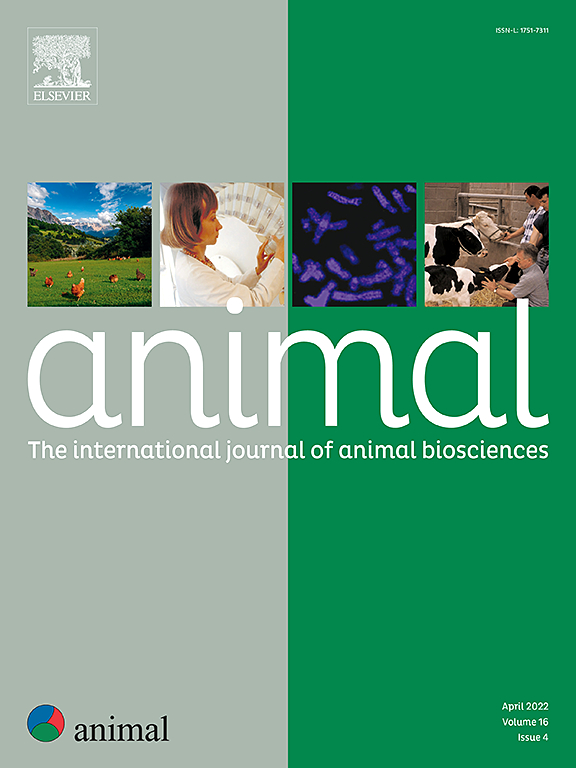Stress response of 18-, 24- and 30-month-old sport horse stallions to a pretraining programme
IF 4
2区 农林科学
Q1 AGRICULTURE, DAIRY & ANIMAL SCIENCE
引用次数: 0
Abstract
Warmblood sires traditionally have been presented for stallion licencing at 2 years of age, but the age at which horses are mentally fit for training is a point of controversy. We have therefore investigated the stress response of young stallions to pretraining for licencing. Salivary cortisol concentration, heart rate and heart rate variability (HRV) were determined repeatedly over 12 weeks. Stallions were 24 and 30 months old and either housed in groups or individual boxes (Group 24, n = 9; Box 24, n = 10; Box 30, n = 10). Pretraining included free movement in an indoor arena, training in a horse walker, lunging and jumping of obstacles without rider. In addition, group-housed 18-month-old stallions (Group 18, n = 10) underwent an abbreviated programme with only free movement and horse walker exercise. We hypothesised that the stress response to pretraining is reduced by group housing but not affected by age. In stallions of all groups, cortisol concentration increased in response to pretraining events (P < 0.001). Cortisol release differed among events (P < 0.001) was most pronounced after free movement in weeks 1 and 2 and became less pronounced with event repetition (P < 0.001). When horses were in the horse walker for the first time, cortisol release was increased in group-housed in comparison to individually housed stallions (time × stable P < 0.001). An increase (P < 0.001) in heart rate differed among events (P < 0.001) and became smaller with repetition (P < 0.001). The HRV decreased transiently in response to pretraining events (P < 0.001) indicating sympathoadrenal activation. In conclusion, pretraining of young stallions is both a physical and a mental demand and induces a stress response. With the repetition of events, even stallions as young as 18 months adapted rapidly to these demands. Group housing had no stress-reducing effects. Our study does not provide evidence that the systematic pretraining of young Warmblood stallions raises animal welfare concerns.
18个月、24个月和30个月运动马对训练前计划的应激反应
传统上,温血种马在两岁时就可以获得种马执照,但马的心理适合训练的年龄是一个有争议的问题。因此,我们调查了年轻种马对许可前训练的应激反应。在12周内反复测定唾液皮质醇浓度、心率和心率变异性(HRV)。24个月和30个月大的种马,被饲养在群体或单独的盒子里(24组,n = 9;框24,n = 10;方格30,n = 10)。预训练包括在室内竞技场的自由运动,在马步行者的训练,在没有骑手的情况下冲刺和跳跃障碍。此外,群养的18个月大的种马(第18组,n = 10)进行了一个简短的计划,只有自由活动和遛马运动。我们假设对预训练的应激反应会因集体住宿而降低,但不受年龄的影响。在所有组的种马中,皮质醇浓度对训练前事件的反应增加(P <;0.001)。皮质醇释放在不同事件间存在差异(P <;0.001)在第1周和第2周自由活动后最为明显,随着事件的重复而变得不那么明显(P <;0.001)。当马第一次进入马步行者时,与单独饲养的种马相比,群养的种马皮质醇释放增加(时间×稳定P <;0.001)。增加(P <;0.001),不同事件间心率差异较大(P <;0.001),并随着重复而变小(P <;0.001)。HRV在训练前事件的反应中短暂下降(P <;0.001)表明交感肾上腺激活。综上所述,公马的预训练是一种生理和心理需求,并引起应激反应。随着事件的不断重复,即使是18个月大的种马也能迅速适应这些要求。集体住房没有减轻压力的效果。我们的研究并没有提供证据表明对温血种马进行系统的预训练会引起动物福利问题。
本文章由计算机程序翻译,如有差异,请以英文原文为准。
求助全文
约1分钟内获得全文
求助全文
来源期刊

Animal
农林科学-奶制品与动物科学
CiteScore
7.50
自引率
2.80%
发文量
246
审稿时长
3 months
期刊介绍:
Editorial board
animal attracts the best research in animal biology and animal systems from across the spectrum of the agricultural, biomedical, and environmental sciences. It is the central element in an exciting collaboration between the British Society of Animal Science (BSAS), Institut National de la Recherche Agronomique (INRA) and the European Federation of Animal Science (EAAP) and represents a merging of three scientific journals: Animal Science; Animal Research; Reproduction, Nutrition, Development. animal publishes original cutting-edge research, ''hot'' topics and horizon-scanning reviews on animal-related aspects of the life sciences at the molecular, cellular, organ, whole animal and production system levels. The main subject areas include: breeding and genetics; nutrition; physiology and functional biology of systems; behaviour, health and welfare; farming systems, environmental impact and climate change; product quality, human health and well-being. Animal models and papers dealing with the integration of research between these topics and their impact on the environment and people are particularly welcome.
 求助内容:
求助内容: 应助结果提醒方式:
应助结果提醒方式:


